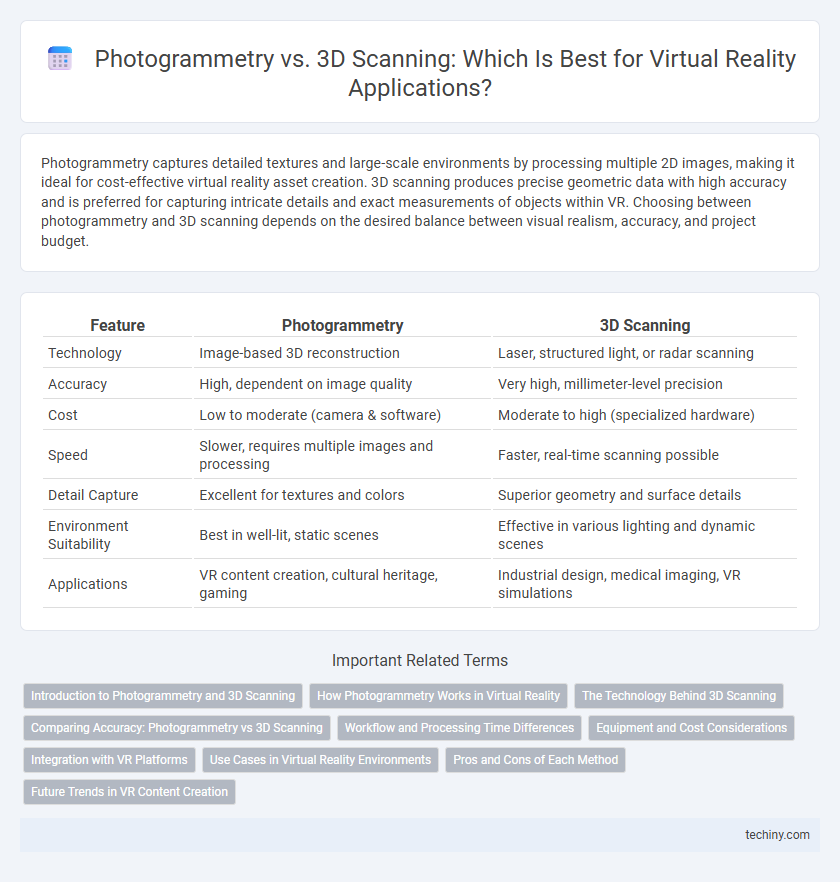Photogrammetry captures detailed textures and large-scale environments by processing multiple 2D images, making it ideal for cost-effective virtual reality asset creation. 3D scanning produces precise geometric data with high accuracy and is preferred for capturing intricate details and exact measurements of objects within VR. Choosing between photogrammetry and 3D scanning depends on the desired balance between visual realism, accuracy, and project budget.
Table of Comparison
| Feature | Photogrammetry | 3D Scanning |
|---|---|---|
| Technology | Image-based 3D reconstruction | Laser, structured light, or radar scanning |
| Accuracy | High, dependent on image quality | Very high, millimeter-level precision |
| Cost | Low to moderate (camera & software) | Moderate to high (specialized hardware) |
| Speed | Slower, requires multiple images and processing | Faster, real-time scanning possible |
| Detail Capture | Excellent for textures and colors | Superior geometry and surface details |
| Environment Suitability | Best in well-lit, static scenes | Effective in various lighting and dynamic scenes |
| Applications | VR content creation, cultural heritage, gaming | Industrial design, medical imaging, VR simulations |
Introduction to Photogrammetry and 3D Scanning
Photogrammetry uses overlapping photographs to create detailed 3D models by calculating spatial relationships between multiple images, relying heavily on camera calibration and image processing algorithms. 3D scanning captures physical objects' geometry directly through laser or structured light sensors, resulting in precise point clouds or meshes. Both technologies are integral in virtual reality for creating immersive, accurate digital environments but differ in data acquisition methods and resulting model fidelity.
How Photogrammetry Works in Virtual Reality
Photogrammetry in virtual reality works by capturing a series of overlapping photographs from multiple angles to create accurate and highly detailed 3D models. Advanced software processes these images by identifying common points and stitching them together to reconstruct the object's geometry and texture. This technique enhances VR environments by providing realistic representations of real-world objects and scenes for immersive user experiences.
The Technology Behind 3D Scanning
3D scanning technology employs laser triangulation, structured light, or time-of-flight sensors to capture accurate spatial data of physical objects, creating detailed digital models with high precision. These techniques measure millions of points on an object's surface, generating dense point clouds essential for realistic virtual reality environments. Unlike photogrammetry, which depends on image processing from multiple photographs, 3D scanning offers faster data acquisition and superior accuracy for complex geometries in VR applications.
Comparing Accuracy: Photogrammetry vs 3D Scanning
Photogrammetry captures high-resolution textures and large-area details with accuracy depending on image quality and processing algorithms, often resulting in slight surface irregularities. 3D scanning provides precise geometrical data through laser or structured light methods, delivering superior dimensional accuracy and consistency in complex shapes. For VR applications requiring exact spatial measurements and realistic environment replication, 3D scanning typically outperforms photogrammetry in accuracy.
Workflow and Processing Time Differences
Photogrammetry captures detailed textures using multiple overlapping photos, requiring extensive image processing and alignment, which increases overall workflow time. In contrast, 3D scanning employs laser or structured light to rapidly capture precise geometry, significantly reducing processing time but often needing additional texture mapping. Choosing between photogrammetry and 3D scanning depends on project requirements for detail accuracy versus speed in virtual reality asset creation.
Equipment and Cost Considerations
Photogrammetry relies on standard digital cameras and specialized software, making it a cost-effective solution for capturing detailed textures but often requires extensive processing time. In contrast, 3D scanning uses advanced hardware such as LiDAR or structured light scanners, which deliver high precision and faster capture but involve significantly higher upfront equipment costs. Evaluating project complexity and budget constraints is essential when choosing between photogrammetry and 3D scanning for virtual reality asset creation.
Integration with VR Platforms
Photogrammetry creates detailed 3D models by processing multiple 2D images, making it highly compatible with VR platforms through seamless texture mapping and photorealistic visuals. In contrast, 3D scanning captures precise geometric data directly from physical objects, enabling accurate spatial representation and easier integration with VR environments that prioritize spatial fidelity. Both methods enhance immersive experiences, but photogrammetry excels in realism while 3D scanning is preferred for exact dimensional accuracy in virtual reality applications.
Use Cases in Virtual Reality Environments
Photogrammetry excels in creating highly detailed, realistic textures ideal for immersive VR environments such as virtual tourism and heritage preservation, where capturing the authenticity of real-world locations is crucial. 3D scanning provides precise geometric data, making it suitable for applications requiring accuracy and repeatability, like industrial training simulations and virtual prototyping in VR. Combining both technologies enhances VR experiences by delivering textured models with accurate spatial dimensions, benefiting gaming, architecture, and medical training scenarios.
Pros and Cons of Each Method
Photogrammetry excels in capturing highly detailed textures and colors using multiple photographs, making it cost-effective and accessible, but it struggles with reflective surfaces and requires significant processing time. 3D scanning offers precise geometric accuracy and works well with complex shapes regardless of lighting, yet it involves expensive equipment and may lack detailed texture information. Choosing between these methods depends on whether priority is on visual realism or dimensional accuracy in virtual reality content creation.
Future Trends in VR Content Creation
Photogrammetry and 3D scanning are evolving as pivotal technologies in VR content creation, with photogrammetry offering high-detail texture capture and 3D scanning providing precise geometric accuracy. Future trends indicate increased integration of AI-driven processing to accelerate model generation and enhance realism, enabling more immersive virtual environments. Advances in real-time photogrammetry and portable 3D scanners are expected to democratize VR content creation, making it more accessible and scalable for diverse applications.
Photogrammetry vs 3D Scanning Infographic

 techiny.com
techiny.com